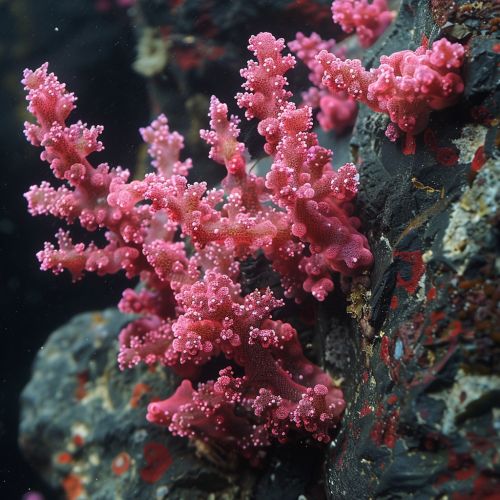Coralline algae
Introduction
Coralline algae are a group of red algae in the order Corallinales. They are characterized by a thallus that is hard because of calcareous deposits contained within the cell walls. The colors of these algae are most typically pink, or some other shade of red, but some species can be purple, yellow, blue, white or gray-green.
Taxonomy and Evolution
Coralline algae belong to the Phylum Rhodophyta, which is commonly known as the red algae. The order Corallinales in which coralline algae fall is characterized by the presence of calcified cell walls, which is not a common feature among other red algae. The order Corallinales is further divided into three families: Corallinaceae, Hapalidiaceae, and Sporolithaceae. Each family is distinguished by its unique morphological features and reproductive structures.
The evolution of coralline algae is a topic of ongoing research. It is believed that these algae have evolved from non-calcified ancestors in the early Cretaceous period. The fossil record of coralline algae dates back to the Late Cretaceous, approximately 100 million years ago.


Morphology and Anatomy
Coralline algae exhibit a wide range of morphological diversity, from highly branched free-living forms to crustose (encrusting) forms that adhere tightly to the substratum. The thallus, or body, of coralline algae is composed of interlocking calcified cells, which give the algae their characteristic hardness and rigidity.
The cells of coralline algae are typically small, square to rectangular in shape, and have heavily calcified cell walls. The cell walls are composed of cellulose impregnated with calcium carbonate, which gives the algae their characteristic pink or red color.
Reproduction
Coralline algae reproduce both sexually and asexually. Sexual reproduction occurs through the formation of reproductive structures called conceptacles, which contain either male or female gametes. Asexual reproduction occurs through fragmentation, where a piece of the thallus breaks off and grows into a new individual.
Ecology and Distribution
Coralline algae are found in all of the world's oceans, from the intertidal zone to depths of up to 270 meters. They play a crucial role in the ecology of coral reefs. They are one of the most important sources of food for a variety of marine organisms, including fish, sea urchins, and chitons.
Coralline algae also play a significant role in the formation of coral reefs. They secrete calcium carbonate, which contributes to the growth and stability of the reef structure. They also compete with other algae for space on the reef, helping to prevent the overgrowth of other potentially harmful algal species.
Economic Importance
Coralline algae have significant economic importance. They are harvested for use in the production of lime for cement. They are also used in the aquarium trade, where they are valued for their ability to promote the growth of coral.
Threats and Conservation
Coralline algae are threatened by a variety of factors, including climate change, ocean acidification, and pollution. These factors can lead to a decrease in the growth and survival of coralline algae, which can have serious implications for the health of coral reefs.
Conservation efforts for coralline algae primarily focus on reducing the impacts of these threats. This includes efforts to reduce greenhouse gas emissions, which are a major contributor to climate change and ocean acidification, and efforts to reduce pollution in marine environments.
